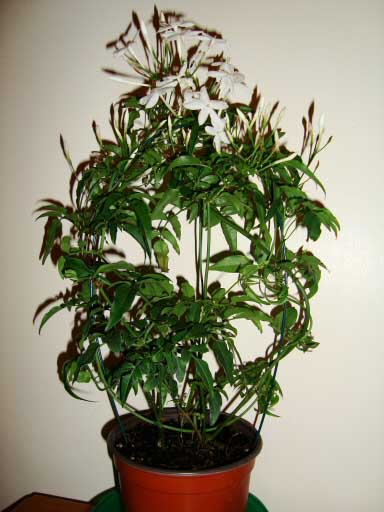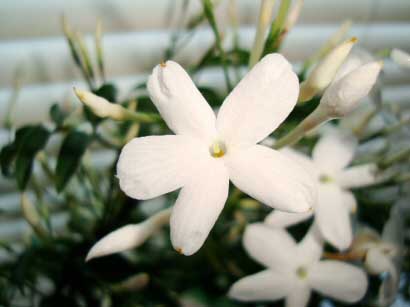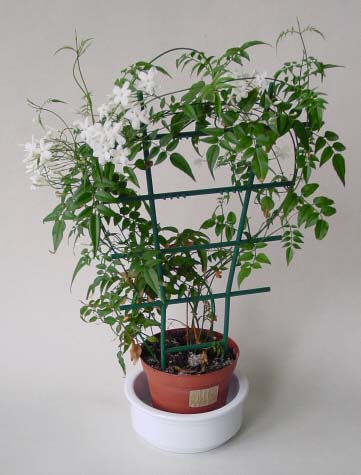





There are several varieties of Jasmine that can live happily indoors as a house plant, although by far the most popular is Jasminum polyanthum, known commonly as Chinese, Star or just plain Jasmine.  A vigorous climber (if left to its own devices) which bears numerous star shaped small flowers that easily mislead because every flower, although tiny, packs an almighty punch to the nose. With just a few of these tiny Jasmine flowers open they can fill a room with their glorious, pungent and delicious heady, slightly sickly scent. You will never ever forget the smell and associations of Jasmine once smelt, much like experiences of Lavender as a child.
A vigorous climber (if left to its own devices) which bears numerous star shaped small flowers that easily mislead because every flower, although tiny, packs an almighty punch to the nose. With just a few of these tiny Jasmine flowers open they can fill a room with their glorious, pungent and delicious heady, slightly sickly scent. You will never ever forget the smell and associations of Jasmine once smelt, much like experiences of Lavender as a child.
Jasmine rivals the Hyacinth in the smelly stakes, coming second in the beauty contest, but winning first place for longevity in the home. The Hyacinth is a temporary guest at best, but the Jasmine will be happy in your home all year if the conditions and care provided is right. The scented flowers last for many weeks due to the sheer number of blooms it produces, which open in sequence ensuring a fantastic long attraction, either in a central spot in your home, or hidden away in a cloakroom to act as a natural air freshener.
Normally cheap to buy, easy to propagate and quite straight forward to care for, Jasmine is also simple enough to get repeat blooms the following year. So the only thing that might put you off, is the smell itself! Make sure you (or whoever you are buying it for) like the scent of Jasmine before purchasing this house plant or you'll quickly grow to hate it!
Light
Whether grown outside or indoors all Jasmine require bright light with some direct sun if possible, therefore a South facing window will be the perfect spot to grow your plant in..
Watering
While it's in flower and is in active growth a Jasmine will need plenty of water. The soil needs to be moist almost all the time, and this is imperative whilst in flower. If the soil dries up then so will the flowers and pending buds. With that said do be careful with the interpretation of the word "moist", soggy conditions or sitting in a tray of water is classed as "wet" not "moist".
Humidity
Misting the leaves (not the flowers) occasionally is beneficial, but no real harm will come if you don't unless the room you have chosen for it is very dry.
Feeding
A moderate fertilizing routine is all that's required as it's not overly demanding when it comes to feeding. For good all round health try providing a standard house plant liquid feed every couple of weeks from late Spring until late Autumn / Fall.
Temperature
Temperature is important for Jasmine plants. During the growing seasons (the naturally warmer months of the year) what nature provides will be fine. So if it's a hot day and temperatures rise, it will accommodate this without issue.
Temperature is important when it comes to Jasmine
However in Winter a cool temperature must be provided, this may prove a problem because often you buy it in bud during the cold months of the year as this is when J. polyanthum tends to flower. The natural inclination with a scented flowering plant is to have it near you in your warm living areas. Resist this if you can and place it in a cooler spot, perhaps in a bathroom or unheated hallway the scent will last far longer if you do. However if you can't resist the heady scent (and who could blame you really), once flowering is over, move to the cooler room immediately. In any event not lower than 5°C / 41°F.
Repotting
An out of control Jasmine is not a pretty sight. Constantly repotting into bigger pots will encourage growth, so you only normally repot when the roots have completely filled the pot. The ideal time to do this is in Spring or Summer however avoid doing it whilst there are buds forming. A well draining standard compost mix is the most suitable.
Propagation
Because cuttings reach maturity so quickly they can flower exceptionally fast when compared to some plants like the Bird of Paradise. Taking Jasmine cuttings to increase your stock or to give them away means propagation is often quite practical and worthwhile.
Take cuttings of Jasmine about 7.5cm / 3in long from newish side shoots. They should then be placed in a potting mix made up of moist compost with some grit, sand or vermiculite to keep the mixture "open" thereby reducing the chances of rot taking hold. Cover the pot in a clear plastic bag, you must make sure the plastic and the other cuttings don't touch one other if you have put multiple cuttings in one pot. So you might want to use sticks of some sort to create a "tent" effect to hold the plastic up and away from the cuttings and soil.
Bright light (not direct sunlight) and warmth are needed and if fully sealed with a clear plastic bag you likely won't need to water again until rooting has taken place. This will take about 4 weeks, after which the protective bag can be removed. At this point, grow on until the roots fill the pots, then either separate the new plants into individual pots, or keep several together to get a fast looking bushy overall effect.
Speed of Growth
The Jasmine growth speed can best be described as vigorous during the warmer months of the year. You must have some sort of support or training in place to keep the plant in check otherwise it will clamber and climb, resulting in a messy appearance (if you're OK with that then let it grow how it wants).
Height / Spread
There is potential for vines up to 6 metres long. However in the home this is very unlikely because the plant looks best as a trained and compact specimen. Some plants like Pothos will fit the home in a long vine capacity, but because Jasmine stems are generally very thin and the leaves equally small, there is very little benefit growing them like this.
Flowers
 Flowers start to form after a sunny and hot Summer and things have begun to cool down as Autumn / Fall knocks at the door. Follow the trends of nature and flowering will happen naturally. This means when things get cooler allow the plant to experience this as well, don't mollycoddle it with artificial warmth. This is because the warm bright Summer will have allowed the plant to grow many new side shoots stems on which the flower buds will later form, however only if they have a chance to "harden off" and this is done when temperatures start to drop.
Flowers start to form after a sunny and hot Summer and things have begun to cool down as Autumn / Fall knocks at the door. Follow the trends of nature and flowering will happen naturally. This means when things get cooler allow the plant to experience this as well, don't mollycoddle it with artificial warmth. This is because the warm bright Summer will have allowed the plant to grow many new side shoots stems on which the flower buds will later form, however only if they have a chance to "harden off" and this is done when temperatures start to drop.
The buds will often start to appear when Winter has well and truly set in and providing the soil is kept moist during this time, they will open and release their heavy scent for weeks and weeks. They are star shaped and either white or slightly pink about 2cm across. After flowering is over, they will quickly go brown and crispy, remove these so the plant doesn't look unattractive.
Anything Else?
 As discussed above, the stems a Jasmine produces can become very long and unruly. It's not essential for any reason other than appearance, but almost all Jasmine grown as a houseplant is done so in a neat looking bush on a trellis or in a upside down horseshoe shape.
As discussed above, the stems a Jasmine produces can become very long and unruly. It's not essential for any reason other than appearance, but almost all Jasmine grown as a houseplant is done so in a neat looking bush on a trellis or in a upside down horseshoe shape.
Stray shoots are pinched out or wrapped around some type of small trellis. It's not hard to do, but if you have positioned your plant in a fantastic spot and water perfectly you will gain stacks of new vigorous growth during the Summer which will mean you may need to prune and train several times a month.
Copyright © www.100flowers.win Botanic Garden All Rights Reserved